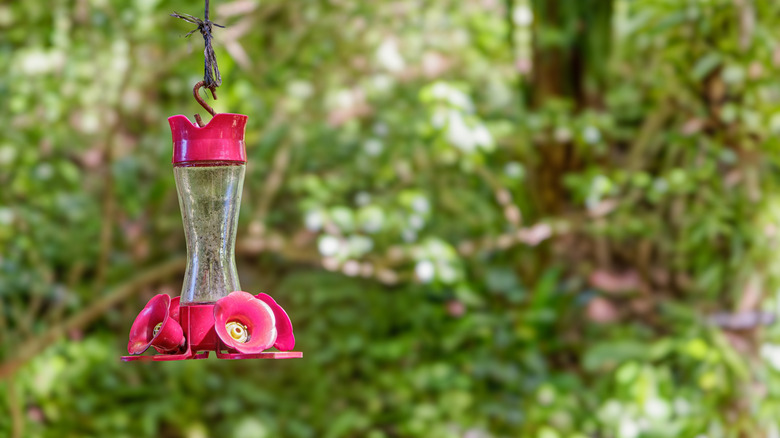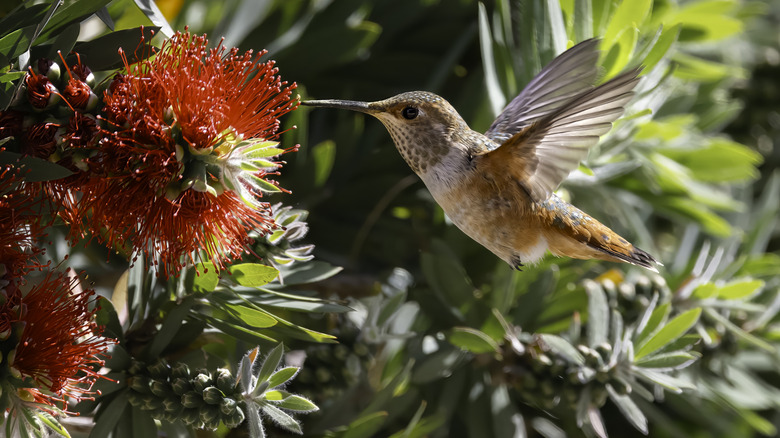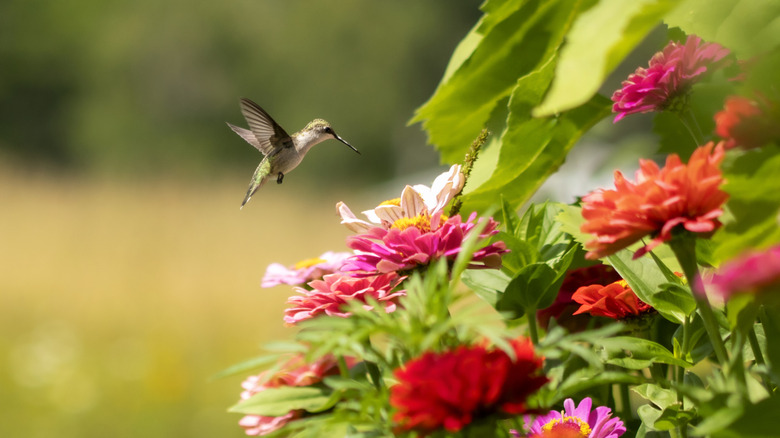Are These Colors Repelling Hummingbirds From Your Feeder?
The whizzing wonder that is a hummingbird can quickly come to your yard if you give them good food sources, such as a feeder or pollinator-friendly flowers. If you've set out a hummingbird feeder full of nectar but it doesn't seem to draw any of these jeweled visitors, the problem might not be with the food itself, but the colors around it. Always on the lookout for their next meal, hummingbirds rely on their incredible eyesight to identify potential food sources, especially the nectar within flowers or feeders. If your yard features an abundance of mostly dull, muted colors like black or gray, the hummers may be repelled, determining it's not worth a stop.
Color is critical for how hummingbirds navigate and find sources of food. They're especially drawn to the color red, not just as a personal preference, but because they've learned to associate it with a nectar-rich food source. Red feeders and flowers often bear the nectar they need to fuel a frenetic flying of 20 to 30 miles per hour. That's why hummers will seek out the yards and gardens filled with these vibrant, bold colors, often spotting them from a far distance. On the flip side, when less-attractive shades such as greens or blues dominate a yard, they'll often overlook it, sometimes even if there's a nectar station present. To get more hummingbirds to nest in your yard, it needs to flourish with the colors they love, so they have a visual cue telling them to stop there for a quick refuel.
Why certain colors repel hummingbirds
Birds and hummingbirds, in particular, see the world in a much richer spectrum than humans. Their exceptional color perception comes from having four types of cones in their retinas, compared to the three types found in humans that let us see red, green, and blue. This fourth cone type is sensitive to ultraviolet light, allowing hummers to see a range of colors, including multiple variations of color wavelengths, known as non-spectral colors, that we're unable to see. Researchers believe that the oil and pigments within their retina cones act as filters, enhancing the color wavelengths of red to yellow. The finely-tuned color perception allows hummingbirds to distinguish between good and poor food sources through association.
Dull colors not only lack association with nectar-rich foods — they may also pale in comparison to other brighter elements in their environment. This seeking behavior is instinctual: As the birds have evolved, they've learned these shades won't reward them with the sugary content they crave. Any flowers or decorations within these colors have a low attraction level. They won't offer the same "pop" of color they want, especially when compared to your neighbor's bright red feeder hung among a dazzling array of colorful blooms. Some muted shades, like gray or darker greens, can often blend in with green foliage, and while a hummer can see the colors, they're in constant motion. They'll simply pass the area while actively foraging, which may leave you with a full feeder without visitors. With this in mind, adding their favorite colors can go a long way toward attracting hummingbirds to your yard.
What colors attract hummingbirds
Because of their keen visual acuity, hummers naturally flock towards reds, yellows, oranges, and pinks in their environment. Many flowers that will transform your space into a hummingbird haven feature these colors, so they'll head to these bright spots on their horizon anticipating a nectar feast. Best of all, they can notice it as they zip through the air at breathtaking speeds in search of food or a mate. You can catch their eye by incorporating red throughout your garden with a feeder or via some blooms, like scarlet bee balm (Monarda didyama) or zinnia (Zinnia elegans). Don't just rely on only one flower; you should combine their preferred flower shades for better visibility and appeal.
While reds, oranges, and pinks reign supreme for their vision preferences, hummers will also flock to shades of white. White creates a bright contrast when set against plants' green leaves, effectively working as an "eat here!" sign for these avian acrobats. Adding a few white flowers can be a helpful visual guide that draws them to the bounty waiting in your garden. When planting anything for the birds, always remember to add native species that won't compete with other plants. Not only have these plants adapted to your area, they also help support its ecosystem as well. Such plants are crucial to pollinators like hummingbirds, butterflies, and bees. Even if you don't have a lot of space for planting, you can incorporate other brightly-colored objects, such as planter boxes, fence posts, or even lawn décor in hummingbirds' favored colors. This way, you can guide them towards your yard and feeder in a way they can't resist.


